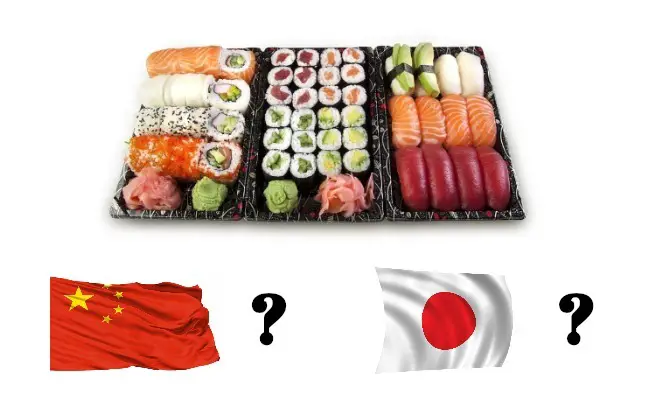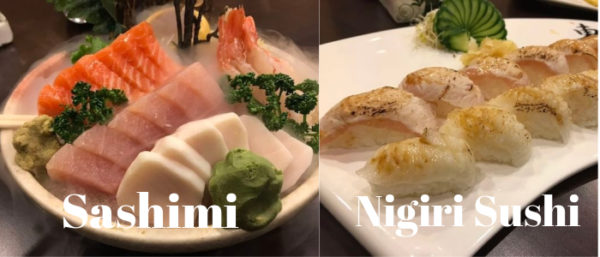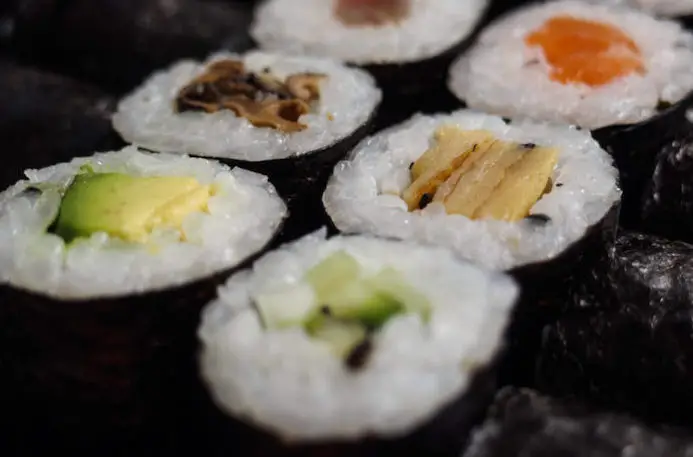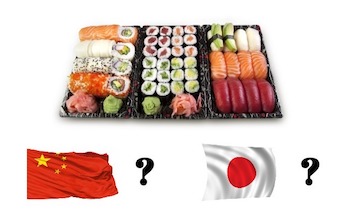We are reader supported. When you purchase through links on our site, we may earn an affiliate commission. Also, as an Amazon affiliate, we earn from qualifying purchases.

It amuses me to see how Americans and people from other western countries confuse between Chinese and Japanese cuisine. One day I introduced my Chinese friend to an American guy and he immediately chirped ‘Oh! You are from China. I love sushi’. I chuckled. I know it’s not just that guy buy many people out there who are confused about the origin of the food they love so much.
So, is sushi Chinese or Japanese food? Although traces of sushi culture can be found in China around the 2nd century, the Chinese only consumed pickled fish and discarded the rice. The first historical evidence of people eating raw fish with rice was found in Japan, hence sushi is Japanese food.
The earlier reference to sushi in Japan appeared in the 8th century and it came to be known as narezushi by the 9th and 10th century. The food may be inspired from southeast Asia and China, but the real adaption of sushi as we know it today was created in Japan.
Contents
What Are References Of Sushi In Chinese Culture
You can find the mention of Narezushi in the Chinese dictionary in the 2nd century CE. Although it involves fish and rice, the method of preparation and the way it was consumed is different from the sushi we know today.
The Han Chinese who were expanding in the southern region of the Yangtze river adopted this food from the non-Han civilization. They used rice not as a part of the food but as a means to preserve the fish, due to lack of refrigeration.
The fermentation of the rice prevented the microbial from spoiling the fish. As the flesh turned acidic due to fermentation, the pH levels dropped below 4.5, making it unfavorable for bacteria formation. This resulted in half-fermented sushi known as namanare.
In the Hunan province in China, they still have a dish that uses rice and salt to ferment fish, so China surely does not have a claim to be the country of origin for sushi.
How Did Sushi Originate In Japan
The inspiration for creating sushi came from South East Asia, and China but the Japanese adaption of the dish was much different from how it was consumed before. Instead of using rice as a means to preserve fish, the Japanese started eating raw fish with rice and this dish was known as
In the Muromachi period, namanare was a popular dish involving raw fish wrapped in vinegared rice, and it was meant to be consumed fresh before the flavor changed. This method of consuming fish was not a means of preservation but a new style of delicacy in Japanese culture.

During the Edo period, the Japanese developed a new style of sushi known as the
Hanaya set up a fast food stall in a busy street close to the coastal area from where he could get fresh fish. Instead of wrapping the fish in rice, he gave an oblong shape of the seasoned sushi rice and then placed a slice of fresh fish over the rice. This was served as a quick snack and became an instant hit with the local people.
What Made Sushi A Visually Appealing And Delightful Food
In the early 19th century, the Japanese did not hold tuna fish in high regard although it was abundantly available. Hanaya thought of presenting it in a delightful way so he served it up slathered with soy sauce. This enhanced the flavor and started a Tuna craze in Tokyo. Today, tuna or maguro is one of the most widely used fish in sushi rolls.
The attractive presentation of nigirizushi combined with the appeal of fresh fish and the quick preparation time made it an instant hit. The sushi Hanaya served in his Edo stall is much similar to what you can see today. He not only used his hands to give shape to vinegared rice but also served sushi with a dab of soy sauce and wasabi.
When Did Sushi Spread To Other Parts Of Japan?
Today, we call this type of sushi ‘nigiri sushi’ (finger sushi) because the rice is shaped with the help of fingers. It is often referred to as the ‘edomae sushi’ derived from Edo, the name of Tokyo during that time. From the streets of Edo, this style of serving nigiri sushi spread far and wide in Japan.
The Great Kanto earthquake in 1923 played a major role in popularizing this style of food throughout Japan. Post the earthquake, several nigirizushi chefs fled from Tokyo (Edo) and settled in different parts of the country. Thus, sushi became a popular dish nationwide.
Sushi Is Not Just Raw Fish

Contrary to what many people still believe today, sushi does not mean raw fish. No doubt, the origin of this world-famous cuisine lies in the tradition of fermenting fish with rice. However, the sushi served in restaurants today is not limited to raw fish but a variety of other cooked meat, vegetables, and fruits.
The humble nigirizushi comprising of an oblong rice bed and a slice of fish on the top has evolved through various generations and each region has added its unique flavor to it. A plethora of seafood variety and seasonal fruits and vegetables are used as toppings and fillings to make sushi more appealing. You can have a look at my previous article here for more information.
How Is The Origin Of Vinegar Related To Sushi
The origin of vinegar has an important role to play in sushi history because it was only after vinegar was formulated, people stopped using the ancient technique of preserving fish for days in fermented rice. When sushi rice was seasoned with vinegar and sugar, it also enhanced the taste of rice and people started enjoying it along with raw fish. This technique spread far and wide as a tradition to make nigirizushi.
As per historical evidence, vinegar was first prepared around 5000 years BC, in Mesopotamia. In between the 4th and 5th centuries, the process of making rice vinegar and wine came from China to Japan. Rice vinegar, widely available under the Mizkan brand first came to the south of Osaka.
The Japanese also made fruit vinegar during the Heian period. Sushi rice seasoned with sake or rice vinegar has been around for a long time. However, given the fact that making narezushi was an extensive process in the Edo period, people started producing vinegar from the lees of sake.
How Is The Origin Of Nori Related To Sushi

Nori has an indispensable significance in the making of sushi as various sushi forms such as temaki and maki rolls make use of seaweed or nori sheets. The oldest reference to Nori is dated to the 8th century when nori was included in taxation.
Nori was consumed as a paste in Japan until the sheets were invented in Edo period around 1750. While the sushi rolls in Japan use nori as a wrap on the outside, the westernized version known as California rolls (click to see recipes) has nori hidden inside the sushi rice.
Related Questions
When was sushi brought to America
Sushi is believed to have arrived on the shores of America in the late 1960s when the Kawafuku Restaurant opened its doors in Los Angeles’ Little Tokyo. Although there are some arguments claiming that sushi was introduced in America as early as 1950, it was not until 1960 that Kawafuku put the cuisine on the national map.
Since then, many Japanese restaurants cropped up in the area and sushi became a popular delicacy loved by Hollywood celebrities, Japanese immigrants and their American friends. The creation of California roll using crabmeat and avocados further made sushi more appealing for the Americans.
After Los Angeles, New York, and Chicago soon followed the craze and several sushi restaurants started by the late 1980s. By the 1990s, sushi became a huge nationwide craze with exclusive sushi bars and restaurants earning good business throughout the country.
Related Article: Difference Between Japanese Sushi And American Sushi
Do they eat sushi in China?
Yes, of course. Let’s not forget that the sushi traveled to Japan through China. Although Japan created the nigirizushi that we know today, they took inspiration for the dish from China. Hence, the Chinese are not unfamiliar to sushi. Interestingly, the sushi restaurants in major cities (for eg. Beijing, Shanghai, and Hong Kong) are run by the Japanese.
Why is sushi important to Japanese culture?
In Japanese culture, people associate a lot of pride in their heritage and cuisine. They use food as a form of expression to display their cultural heritage. As the Japanese are known to value perfection in every field, sushi is also no exception.
In Japan, chefs undergo years of training to perfect the art of sushi making. With attention to minute details, perfect balance of texture and flavors, they don’t just prepare food but create a work of art. No wonder people visiting Japan have ‘eating at a traditional sushi restaurant’ as a priority in their itinerary.
Why do Japanese eat sushi?
Japan is a country surrounded by oceans across its border, and the water body is abundant with fish and other seafood. No wonder, fish takes place as a staple diet in Japan and several dishes involve fish, both cooked and raw.
Contrary to what non-Japanese think, people in Japan don’t eat sushi daily nor do they make only ‘sushi’ at home for all occasions. However, sushi is an important food and the Japanese take pride in their sushi culture. If you visit a sushi bar in Japan, you can see modest nigirizushi and sushi rolls, unlike the fat and decorative sushi you find in the western countries.


Comments
Pingback: Difference Between Japanese Sushi And American Sushi - Easy Homemade Sushi